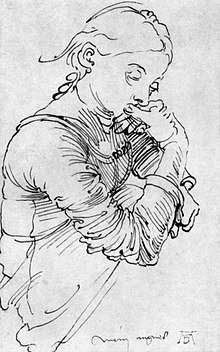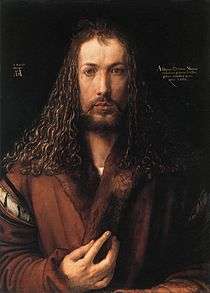Agnes Dürer
| Agnes Dürer | |
|---|---|
 | |
| Born |
1475 Nuremberg |
| Died |
1539 (aged 63–64) Nuremberg |
| Nationality | Germany |

Agnes Dürer née Frey (1475–1539) was the wife of the German artist Albrecht Dürer. During their marriage, which was childless, she was portrayed several times by Dürer.

Agnes Dürer was the daughter of the coppersmith and lute maker Hans Frey and his wife Anna, a member of the patrician family Rummel.
On 7 July 1494 Agnes married Albrecht Dürer, who was forced to stop his grand tour of Europe by his parents in order to marry her. According to the family chronicle she had a dowry of 200 guilders.
A first portrait drawing of Agnes from 1494 is known. Agnes Dürer was mostly responsible for the marketing of her husband's prints. They regularly visited fairs in order to sell his engravings; but usually they sold his prints at the Nuremberg weekly market. Their participation in fairs in Leipzig and Frankfurt are also documented. From September 1505 until May 1506 she did not return to her hometown from a visit to Frankfurt, probably because in Nuremberg the plague had broken out.
During the second trip by Albrecht Dürer to Italy she ran the workshop. In the years 1520 and 1521 the couple traveled together in the Netherlands. The last known portrait of her which was painted on her 27th wedding anniversary, was from this period.
Her marriage with Albrecht Dürer remained childless. With Albrecht Dürer the family name died out. The marriage was not a generally happy one, as indicated by the letters of Albrecht Dürer in which he quipped to Willibald Pirckheimer in an extremely rough tone about his wife. He called her an "old crow" and made other vulgar remarks. Pirckheimer also made no secret of his antipathy towards Agnes, describing her as a miserly shrew with a bitter tongue, who helped cause Dürer's death at a young age.[1] It is widely believed Albrecht was bisexual, if not homosexual, due to several of his works containing themes of homosexual desire, as well as the intimate nature of his correspondence with certain very close male friends.[2]
After the death of her husband (she was the sole heir), Agnes Dürer continued to sell his works. This was confirmed by Charles V, Holy Roman Emperor in 1528 with his purchase of Dürer's book Of human proportions. She died in 1539 in Nuremberg.
Literature
- Hans Rupprich (ed. ): Dürer Written papers. Volume 1, autobiographical writings, correspondence, seals, inscriptions, notes and reports, certificates for personal life, German Association for the Arts, Berlin 1956
- Albrecht Durer: The Complete Works The Complete Paintings, drawings, engravings and woodcuts. The monograph "Albrecht Dürer, work and impact" by Fyodor Anzelewsky. Changed edition, Direct Media Publ, Berlin 2000, 1 CD-ROM (Digital Library; 28th) ISBN 3-89853-128-7
References
- ↑ Harry John Wilmot-Buxton; Edward John Poynter (1881). German, Flemish and Dutch Painting. Scribner and Welford. p. 24.
- ↑ George Haggerty (5 November 2013). Encyclopedia of Gay Histories and Cultures. Taylor & Francis. p. 262. ISBN 978-1-135-58513-6.
External links
- Literature by and about Agnes Dürer in the German National Library catalogueGerman National Library
